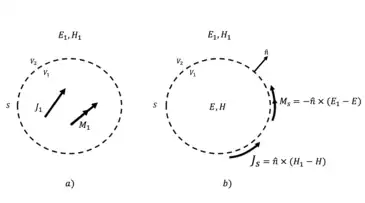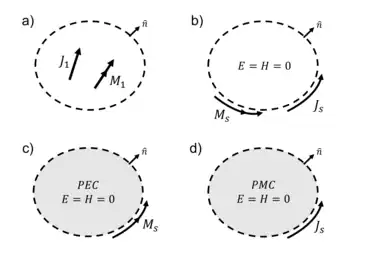
In electromagnetism, surface equivalence principle or surface equivalence theorem relates an arbitrary current distribution within an imaginary closed surface with an equivalent source on the surface. It is also known as field equivalence principle,[1] Huygens' equivalence principle[2] or simply as the equivalence principle.[3] Being a more rigorous reformulation of the Huygens–Fresnel principle, it is often used to simplify the analysis of radiating structures such as antennas.
Certain formulations of the principle are also known as Love equivalence principle and Schelkunoff equivalence principle, after Augustus Edward Hough Love and Sergei Alexander Schelkunoff, respectively.
Physical meaning
General formulation
The principle yields an equivalent problem for a radiation problem by introducing an imaginary closed surface and fictitious surface current densities. It is an extension of Huygens–Fresnel principle, which describes each point on a wavefront as a spherical wave source. The equivalence of the imaginary surface currents are enforced by the uniqueness theorem in electromagnetism, which dictates that a unique solution can be determined by fixing a boundary condition on a system. With the appropriate choice of the imaginary current densities, the fields inside the surface or outside the surface can be deduced from the imaginary currents.[4] In a radiation problem with given current density sources, electric current density and magnetic current density , the tangential field boundary conditions necessitate that
where and correspond to the imaginary current sources that are impressed on the closed surface. and represent the electric and magnetic fields inside the surface, respectively, while and are the fields outside of the surface. Both the original and imaginary currents should produce the same external field distributions.[4]
Love and Schelkunoff equivalence principles

Per the boundary conditions, the fields inside the surface and the current densities can be arbitrarily chosen as long as they produce the same external fields.[3] Love's equivalence principle, introduced in 1901 by Augustus Edward Hough Love,[5] takes the internal fields as zero:
The fields inside the surface are referred as null fields. Thus, the surface currents are chosen as to sustain the external fields in the original problem. Alternatively, Love equivalent problem for field distributions inside the surface can be formulated: this requires the negative of surface currents for the external radiation case. Thus, the surface currents will radiate the fields in the original problem in the inside of the surface; nevertheless, they will produce null external fields.[1]
Schelkunoff equivalence principle, introduced by Sergei Alexander Schelkunoff,[6][7][8] substitutes the closed surface with a perfectly conducting material body. In the case of a perfect electrical conductor, the electric currents that are impressed on the surface won't radiate due to Lorentz reciprocity. Thus, the original currents can be substituted with surface magnetic currents only. A similar formulation for a perfect magnetic conductor would use impressed electric currents.[1]
The equivalence principles can also be applied to conductive half-spaces with the aid of method of image charges.[1][4]
Applications
The surface equivalence principle is heavily used in the analysis of antenna problems to simplify the problem: in many of the applications, the close surface is chosen as so to encompass the conductive elements to alleviate the limits of integration.[4] Selected uses in antenna theory include the analysis of aperture antennas[9] and the cavity model approach for microstrip patch antennas.[10] It has also been used as a domain decomposition method for method of moments analysis of complex antenna structures.[11] Schelkunoff's formulation is employed particularly for scattering problems.[2][12][13][14]
The principle has also been used in the analysis design of metamaterials such as Huygens’ metasurfaces[15][16] and plasmonic scatterers.[17]
See also
References
- 1 2 3 4 Rengarajan, S.R.; Rahmat-Samii, Y. (2000). "The field equivalence principle: illustration of the establishment of the non-intuitive null fields" (PDF). IEEE Antennas and Propagation Magazine. 42 (4): 122–128. Bibcode:2000IAPM...42..122R. doi:10.1109/74.868058.
- 1 2 Chew, W.C.; Lu, C.C. (July 1993). "The use of Huygens' equivalence principle for solving the volume integral equation of scattering". IEEE Transactions on Antennas and Propagation. 41 (7): 897–904. Bibcode:1993ITAP...41..897C. doi:10.1109/8.237620.
- 1 2 Harrington 2001, p. 106-109.
- 1 2 3 4 Balanis 2012, p. 328-331.
- ↑ Love, A. E. H. (1901). "The Integration of the Equations of Propagation of Electric Waves". Philosophical Transactions of the Royal Society A. 197 (287–299): 1–45. Bibcode:1901RSPTA.197....1L. doi:10.1098/rsta.1901.0013.
- ↑ Schelkunoff, S. A. (1936). "Some Equivalence Theorems of Electromagnetics and Their Application to Radiation Problems". Bell Labs Technical Journal. 15 (1): 92–112. doi:10.1002/j.1538-7305.1936.tb00720.x.
- ↑ Schelkunoff, S. A. (1939). "On Diffraction and Radiation of Electromagnetic Waves". Physical Review. 56 (4): 308–316. Bibcode:1939PhRv...56..308S. doi:10.1103/PhysRev.56.308.
- ↑ Schelkunoff, S. A. (1951). "Kirchhoof's formula, its vector analogue, and other field equivalence theorems". Communications on Pure and Applied Mathematics. 4 (1): 43–59. doi:10.1002/cpa.3160040107.
- ↑ Balanis 2005, p. 653-660.
- ↑ Kinayman & Aksun 2005, p. 300.
- ↑ Li, Mao-Kun; Chew, Weng Cho (2007). "Wave-Field Interaction With Complex Structures Using Equivalence Principle Algorithm". IEEE Transactions on Antennas and Propagation. 55 (1): 130–138. Bibcode:2007ITAP...55..130L. doi:10.1109/TAP.2006.888453. S2CID 46424215.
- ↑ Balanis 2012, p. 333.
- ↑ Barber, P.; Yeh, C. (1975). "Scattering of electromagnetic waves by arbitrarily shaped dielectric bodies". Applied Optics. 14 (12): 2864–2872. Bibcode:1975ApOpt..14.2864B. doi:10.1364/AO.14.002864. PMID 20155124.
- ↑ Yuan, X.; Lynch, D.R.; Strohbehn, J.W. (March 1990). "Coupling of finite element and moment methods for electromagnetic scattering from inhomogeneous objects". IEEE Transactions on Antennas and Propagation. 38 (3): 386–393. Bibcode:1990ITAP...38..386Y. doi:10.1109/8.52246.
- ↑ Epstein, Ariel; Eleftheriades, George V. (2016). "Huygens' metasurfaces via the equivalence principle: design and applications". Journal of the Optical Society of America B. 33 (2): A31–A50. Bibcode:2016JOSAB..33A..31E. doi:10.1364/JOSAB.33.000A31.
- ↑ Selvanayagam, Michael; Eleftheriades, George. V. (October 2012). "An Active Electromagnetic Cloak Using the Equivalence Principle". IEEE Antennas and Wireless Propagation Letters. 22: 1226–1229. Bibcode:2012IAWPL..11.1226S. doi:10.1109/LAWP.2012.2224840. S2CID 45470309.
- ↑ Memarzadeh, Babak; Mosallaei, Hossein (2011). "Array of planar plasmonic scatterers functioning as light concentrator". Optics Letters. 36 (13): 2569–2571. Bibcode:2011OptL...36.2569M. doi:10.1364/OL.36.002569. PMID 21725482.
- Bibliography
- Balanis, Constantine A. (2005). Antenna Theory: Analysis and Design (3rd ed.). John Wiley and Sons. ISBN 047166782X.
- Balanis, Constantine A. (2012). Advanced Engineering Electromagnetics. John Wiley & Sons. ISBN 978-0-470-58948-9.
- Harrington, Roger F. (2001). Time-Harmonic Electromagnetic Fields. McGraw-Hill. ISBN 9780070267459.
- Kinayman, Noyan; Aksun, M. I. (2005). Modern Microwave Circuits. Norwood: Artech House. ISBN 9781844073832.